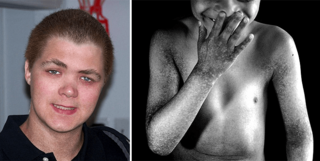Related Research Articles

Adducted thumb syndrome recessive form is a rare disease affecting multiple systems causing malformations of the palate, thumbs, and upper limbs. The name Christian syndrome derives from Joe. C. Christian, the first person to describe the condition. Inheritance is believed to be autosomal recessive, caused by mutation in the CHST14 gene.

Acanthosis nigricans is a medical sign characterised by brown-to-black, poorly defined, velvety hyperpigmentation of the skin. It is usually found in body folds, such as the posterior and lateral folds of the neck, the armpits, groin, navel, forehead and other areas.

Lichen planus (LP) is a chronic inflammatory and immune-mediated disease that affects the skin, nails, hair, and mucous membranes. It is not an actual lichen, and is only named that because it looks like one. It is characterized by polygonal, flat-topped, violaceous papules and plaques with overlying, reticulated, fine white scale, commonly affecting dorsal hands, flexural wrists and forearms, trunk, anterior lower legs and oral mucosa. Although there is a broad clinical range of LP manifestations, the skin and oral cavity remain as the major sites of involvement. The cause is unknown, but it is thought to be the result of an autoimmune process with an unknown initial trigger. There is no cure, but many different medications and procedures have been used in efforts to control the symptoms.

Hyperpigmentation is the darkening of an area of skin or nails caused by increased melanin.

Livedo reticularis is a common skin finding consisting of a mottled reticulated vascular pattern that appears as a lace-like purplish discoloration of the skin. The discoloration is caused by reduction in blood flow through the arterioles that supply the cutaneous capillaries, resulting in deoxygenated blood showing as blue discoloration. This can be a secondary effect of a condition that increases a person's risk of forming blood clots, including a wide array of pathological and nonpathological conditions. Examples include hyperlipidemia, microvascular hematological or anemia states, nutritional deficiencies, hyper- and autoimmune diseases, and drugs/toxins.
Hyperimmunoglobulinemia E syndrome (HIES), of which the autosomal dominant form is called Job's syndrome or Buckley syndrome, is a heterogeneous group of immune disorders. Job's is also very rare at about 300 cases currently in the literature.
Pallister–Killian syndrome is an extremely rare genetic disorder occurring in humans. Pallister–Killian occurs due to the presence of the anomalous extra isochromosome 12p, the short arm of the twelfth chromosome. This leads to the development of tetrasomy 12p. Because not all cells have the extra isochromosome, Pallister–Killian is a mosaic condition.

Naegeli–Franceschetti–Jadassohn syndrome (NFJS), also known as chromatophore nevus of Naegeli and Naegeli syndrome, is a rare autosomal dominant form of ectodermal dysplasia, characterized by reticular skin pigmentation, diminished function of the sweat glands, the absence of teeth and hyperkeratosis of the palms and soles. One of the most striking features is the absence of fingerprint lines on the fingers.

Dermatopathia pigmentosa reticularis is a rare, autosomal dominant congenital disorder that is a form of ectodermal dysplasia. Dermatopathia pigmentosa reticularis is composed of the triad of generalized reticulate hyperpigmentation, noncicatricial alopecia, and onychodystrophy.
Linear and whorled nevoid hypermelanosis is a disorder of pigmentation that develops within a few weeks of birth and progresses for one to two years before stabilizing. There is linear and whorled hyperpigmentation following the lines of Blaschko without preceding bullae or verrucous lesions. It is important to exclude other pigmentary disorders following the Blaschko lines before making a diagnosis of linear and whorled nevoid hypermelanosis. The differential diagnoses include incontinentia pigmenti, linear epidermal nevus, hypomelanosis of Ito and Goltz syndrome. Recently, a case of linear and whorled nevoid hypermelanosis was reported in a Malaysian Chinese girl.

Lelis syndrome it is a genetic disorder, a rare condition with dermatological and dental findings characterized by the association of ectodermal dysplasia with acanthosis nigricans. Other clinical features may include palmoplantar hyperkeratosis, nail dystrophy, intellectual deficit, disturbances of skin pigmentation and hypodontia. Transmission is autosomal recessive.

A sebaceous adenoma, a type of adenoma, a cutaneous condition characterized by a slow-growing tumor usually presenting as a pink, flesh-coloured, or yellow papule or nodule.
Howel–Evans syndrome is an extremely rare condition involving thickening of the skin in the palms of the hands and the soles of the feet (hyperkeratosis). This familial disease is associated with a high lifetime risk of esophageal cancer. For this reason, it is sometimes known as tylosis with oesophageal cancer (TOC).

X-linked reticulate pigmentary disorder is a rare X-linked genetic condition in which males manifest multiple systemic symptoms and a reticulated mottled brown pigmentation of the skin, which, on biopsy, demonstrated dermal deposits of amyloid. Females usually only have linear streaks of hyperpigmentation.
Yemenite deaf-blind hypopigmentation syndrome is a condition caused by a mutation on the SRY-related HMG-box gene 10.
Terminal osseous dysplasia with pigmentary defects is a cutaneous condition characterized by hyperpigmented, atrophic facial macules.

Poikiloderma vasculare atrophicans (PVA), is a cutaneous condition characterized by hypo- or hyperpigmentation, telangiectasia and skin atrophy. Other names for the condition include prereticulotic poikiloderma and atrophic parapsoriasis. The condition was first described by pioneer American pediatrician Abraham Jacobi in 1906. PVA causes areas of affected skin to appear speckled red and inflamed, yellowish and/or brown, gray or grayish-black, with scaling and a thinness that may be described as "cigarette paper". On the surface of the skin, these areas may range in size from small patches, to plaques, to neoplasms.
Heerfordt syndrome is a rare manifestation of sarcoidosis. The symptoms include inflammation of the eye (uveitis), swelling of the parotid gland, chronic fever, and in some cases, palsy of the facial nerves.

Laugier–Hunziker syndrome is a cutaneous condition characterized by hyperpigmentation of the oral mucosa, longitudinal melanonychia, and genital melanosis.
References
- 1 2 Rapini, Ronald P.; Bolognia, Jean L.; Jorizzo, Joseph L. (2007). Dermatology: 2-Volume Set. St. Louis: Mosby. p. 955. ISBN 978-1-4160-2999-1.
- ↑ McCormack, CJ; Cowen P. (May 1997). "Haber's syndrome". Australas. J. Dermatol. 38 (2): 82–4. doi:10.1111/j.1440-0960.1997.tb01113.x. PMID 9159964. S2CID 32988112.